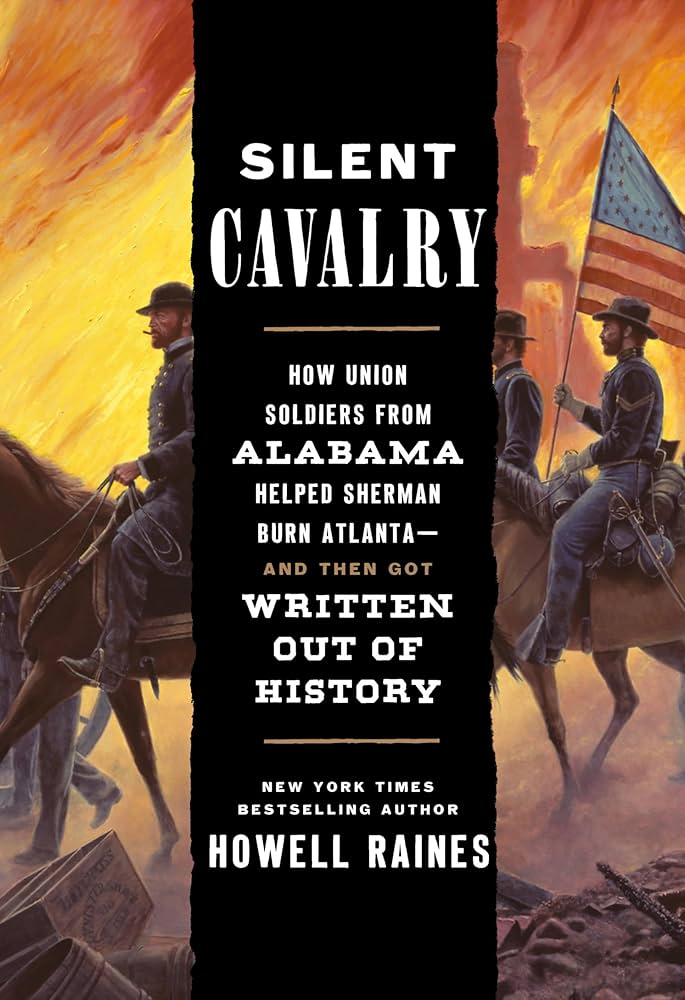By Howell Raines.
New York: Crown Publishing, 2023.
ISBN 978-0-5931-3775-8. Photographs. Notes. Bibliography. Index.
Pp. xii, 541. $36.00.
Howell Raine’s Silent Cavalry defies traditional historiographical categorization. Part primary source history, part family ancestry, and part cultural engagement, the work explores how “Alabama scholars expended thousands of hours in denial” to expunge the wartime role of Alabamian Unionists in general, and the Union 1st Alabama Cavalry Regiment in particular, from the historical record. The resulting narrative emerges as a sort of memoir of historical-familial discovery as Raines delves into his own family history in the region and makes a concerted argument that post-Civil War historians and archivists in the South intentionally downplayed or erased mention of the maligned 1st Alabama Cavalry.
As pertains to historical analysis, Raines, a former New York Times editor and Pulitzer Prize-winning journalist, explains how the seemingly forgotten Alabama regiment earned everlasting condemnation from elite Southerners for participating in Major General Wiliam T. Sherman’s assault on Atlanta, the destructive “March to the Sea,” and his Carolinas Campaign in the last months of the war. Comprising 2,066 volunteers recruited from the hill country of northern Alabama with deep Unionist sympathies in the Andrew Jackson tradition, the 1st Alabama may have also contributed to Union efforts at Stones River, Vicksburg, and Chickamauga, although Raines does not fully support those claims. Predictably, these Alabamians, who had little in common with the plantation society that dominated state politics and committed the state to join the Confederacy, endured severe condemnation and harassment both during and after the conflict for not supporting the rebellion.
Moving beyond history, readers may ascertain that Raines’s most important purpose is to articulate how proponents of the Lost Cause myth created a fiction of Southern unity and aristocracy and thus had to purposefully remove the inconvenient accomplishments and loyalties of the 1st Alabama from the historical record and public memory. As quoted in the book, one Southern author denigrated the regiment by stating, “Alabama’s Unionist regiment played only a marginal role in Civil War combat and that only the oddness of its origins could be of serious interest to historians.” Further, Raines, who is seeking to remedy some kind of personal moral injury, investigates how not only historians, but Southern archivists, diligently worked to either remove or defame the Unionist Alabamians from archives, books, journals, and memoirs.
Silent Cavalry is a substantial work that is divided into three sections: the Lost Cause cadre’s purposeful removal or slandering of Unionist Alabamians; the combat role of the 1st Alabama Cavalry; and an in-depth discussion of the broader role of the Lost Cause movement in American history and memory. While the latter section is perhaps overly long and dwells too long on events and controversies in the mid-20th century, and the chapter on Confederate Lieutenant General Jubal Early seems unnecessarily specific, the larger narrative nevertheless offers a sincere, emotionally connected work that connects Raines’s personal journey with an argument that deeds of the 1st Alabama Cavalry should be remembered and placed in their proper context. The resulting work, while falling short of an unbiased study even as it condemns the biases of historians past, makes an important contribution to the ongoing evolution of memory surrounding America’s most destructive and divisive conflict.
Lieutenant Colonel Nathan Jennings, USA
Fort Leavenworth, Kansas
